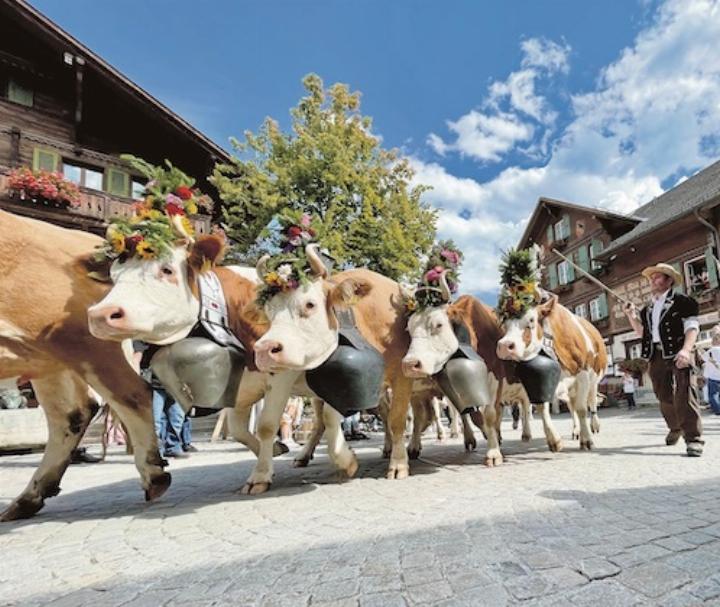The long and traditional history of the cows coming home
03.09.2022 LifestylePeople come from far and wide to witness the cacophonous progression of the cows returning to their home, the Gstaad valley. But how long has this gone on for? Why is it such a special event? Read on for all you need to know about the local Züglete …
One of the many charms of Saanenland – and there are many – is a humble procession that people come from miles around to see. It is at once a happy and sad affair, full of cheering, music, flowers, and that bittersweet feeling that accompanies the end of a long and lovely summer.
I’m talking about the Züglete, of course. It’s a procession that happens every year in September, as the farmers take their cows down from their temporary home on the alpine highlands to greener pastures in anticipation of the cold winter snows.
“But, wait!” I hear you say, “Isn’t this happening all over Switzerland? Not just Gstaad?” It’s true; it is. But the novelty in the Züglete lies in its uniqueness. All the cows must come down for the winter, but how and when the Swiss farmers do it differs depending on what area of Switzerland you are in. Désalpes, Alpabfahrt, Almabtrieb – there are many different names for the parade, and typical to Switzerland, celebrated in four different languages and in a hundred different ways. Back in the High Middle Ages, some remote villages were cut off from the lowlands come wintertime, and the traditions they created there differ widely from towns a few roads over, yet still endure to this day. Over the next three months, over 350,000 cows around Switzerland will make the long trek down, and every year is just as exciting to see as the year before.
Up at the crack of dawn, farmers take down their bells from the eves of their “alps,” the small cabins high up on the ranges. Each cow lovingly has a bell draped around its neck and gets sent out into the paddock ringing and tolling for its last wander along the grassy ridges – at least until next year. Then the farmers round them up and start the journey down into the town and beyond.
What started out as a long, lonely, and slow trek for the farmers almost 5000 years ago (that’s 3000 B.C., in case you were wondering) has evolved into a cheerful affair, with “fair” being the keyword. The day opens with a concert from the Menuhin festival in the local chapel, while on the Gstaad promenade, you’ll find little stalls selling the local cheese that has been made over the summer, along with jams and homemade biscuits and artisanal goods alike – the locals stay busy!
Farmers take massive pride in this occasion and their livestock – after all, what other cows do you know that get to have a months-long summer holiday in one of the most prestigious resorts in the world? The cows are decorated with crowns and garlands of pine wreaths and flowers galore, and I’m sure they are later donated towards the cows’ meal at the end of the trek as a “well done” for the journey.
It’s not just the cows that are well-dressed – the herders dress up too. Both women, men, and children wear their trditional Swiss garb for the special occasion , but with the addition of modern hiking boots. It is a long day after all. The cows and herders can travel over 1,300 metres in elevation over the course of the day (remember, they did this on the way up, too!), so it’s important that both farmer and livestock are well prepared.
It’s become a quasi-tradition for the cows to stop and take a drink at the local fountain opposite Prada – you’ll recognise it by the little bronze calf statue, which is both a delight for our smallest of tourists and a marker for the cows to take the hint and have a drink. You can lead a cow to water, but you can’t make it drink … unless it’s better-than-bottled alpine water on one of the most affluent high streets in the world!
The Züglete has been a common practice in Gstaad since at least the 13th century, with our beloved St. Nicolas chapel having watched the joyous procession for most of those years, having been built in 1402. The chapel has seen the procession grow from a long, hard slog for the farmers to a day that they look forward to all year round. The Züglete is so well-regarded, its reputation almost precedes the town, and it’s one of the unmissable events of the region.
Why not come and hear the cacophony for yourself come September? There’s nothing quite like a festive atmosphere and a little local raclette to end the summer months with a flourish.




